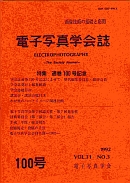Volume 31, Issue 3
Displaying 1-6 of 6 articles from this issue
- |<
- <
- 1
- >
- >|
-
1992Volume 31Issue 3 Pages 367-379
Published: 1992
Released on J-STAGE: June 06, 2007
Download PDF (2486K) -
Effects of Environmental and Physical Parameters on the Electrostatic Charge Distributions of Toners1992Volume 31Issue 3 Pages 380-385
Published: 1992
Released on J-STAGE: June 06, 2007
Download PDF (917K) -
1992Volume 31Issue 3 Pages 386-391
Published: 1992
Released on J-STAGE: June 06, 2007
Download PDF (1027K) -
1992Volume 31Issue 3 Pages 400-406
Published: 1992
Released on J-STAGE: June 06, 2007
Download PDF (1266K) -
1992Volume 31Issue 3 Pages 407-412
Published: 1992
Released on J-STAGE: June 06, 2007
Download PDF (710K) -
1992Volume 31Issue 3 Pages 392-399
Published: 1992
Released on J-STAGE: June 06, 2007
Download PDF (1366K)
- |<
- <
- 1
- >
- >|
